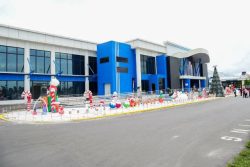What is unfolding in Guyana at this time is, we are being told, an attempt to channel some of our petro resources into a wide-ranging countrywide physical makeover, aspects of which are ongoing in the capital and its environs and in other parts of the coastal plain. What we are discovering in the process is that the ‘makeover’ that had long rested on the good fortune of ‘finding oil’ must, as well, be attended by varying measures of vision as well as particular skills and talents. Advancement cannot drop out of thin air. It has to be conceptualized and afterwards, refined in the minds that are suitably trained to do so before it is applied ‘on the ground,’ so to speak.
What we are also discovering, increasingly, is that the makeover that we had fashioned in our minds after our petro-dream had become a reality will have to be tested before they can be applied. Equally important, perhaps, is that there is a price to be paid for such exalted ambitions we dare to embrace. Some of our petro-driven ambitions is evidenced in the emergence of development-related assignments that include elaborate coastal makeover ambitions. These manifest themselves in planning processes that envisage, among other things, tearing down and building back better infrastructure, and other forms of upgrading that bring with them in equal measures of short to medium-term national challenges. This, all too often, is the price we must pay for embracing the ambition of going forward.
Needless to say, the price of ambition can only be paid by assuming a mindset of being prepared for and embracing challenges that inhere in exalting those ambitions, in the first place. The extent of the national challenge residing in the realization of Guyana’s petro dreams cannot be captured in this space. There are some important aspects of that challenge, however, that can be understood by examining the nature of some of the assignments that we are going to have to undertake. One of those, an important one, is the transformations and changes that repose in the ongoing effort to move the coastal upgrading outside of Georgetown, and its environs, and into the whole of the country. Here, one hastens to add that this will take time, planning and a capacity for effective execution.
To capture some of the implications of what, in effect, is an important aspect of the wider transformation process, there is need to examine some issues associated with the readying of the two parallel roadways that take us through the communities along the East Coast and further east into some of the other strategic (for one reason or another) regions of the country. If much has been done in recent years to (partially) prepare the East Coast Highway to support some of the country’s important development ambitions, more will have to be done, going forward, (and at considerable financial cost) to keep the East Coast Highway ‘going.’ With the roughly parallel road, (what is usually referred to as the Railway Embankment) the challenge will be no less formidable. Indeed, there is a good chance that in some respects it will be considerably more demanding.
As this editorial is being written, the Railway Embankment is enduring the hardships of a surface which, while it has undergone significant chunks of rehabilitation and reconfiguration, remains vulnerable to pounding by unceasing heavy traffic flows associated with other major undertakings along its route. Here, it has to be said that at the moment significant sections of what is commonly described as the Railway Embankment may well be edging ever closer to altogether becoming unfit for purpose. That the daily movement of two-way traffic along the Railway Embankment ensues simultaneously with major in-progress works, including the movement of properties and the reconfiguring of important infrastructure along the embankment, is a circumstance that has to be seen to be believed. The works include a combination of road rehabilitation, the reconfiguration of electrical installations, parapets and canals, the reconfiguring of canals and the pushing back of fences, bridges and gates (of private homes) to make room for what we are being told will be a four-lane highway.
When the various works related to these exercises are, simultaneously examined, the Railway Embankment becomes, arguably, one of the more inhospitable pieces of strategically important roadway anywhere in coastal Guyana. Significant works currently in progress on several ‘fronts’ on or immediately off the Railway Embankment mean that cars and minibuses must compete with trucks. These trucks relentlessly pound the railway embankment at all hours, (as we say in Guyana), the operators of the vehicles often altogether unmindful of the hazards that obtain on a roadway which is considerably indented and torn up, mostly on account of its 24-hour use by heavy-duty vehicles and decidedly poorly lit in some sections.
Contextually, the best that can be said by the Ministry of Works’ August 30 ‘stay away from East Coast Embankment’ directive to ‘all truck drivers’ is that it is regrettably belated, a classic example of securing of the stable doors long after the horses have bolted. Indeed, the eventualities that have now forced the ‘stay away’ missive (Trucks must stay away from East Coast Railway Embankment – Ministry Works August 31, 2024) were already patently apparent some time ago (was there ever a sounding of voices by the Police Traffic Department in this matter?) nor can there be any excuse for the Ministry of Works’ decidedly belated recognition that the relentless pounding of what is usually referred to as the ‘Railway Embankment’ needed to be addressed much earlier.
In the matter of the Ministry’s recent directive that the trucks immediately be redirected to the East Coast Highway that option, in itself, may not be without its attendant traffic-related challenges. Still, the primary consideration here, surely, has to be with the exercise of relieving the Railway Embankment Corridor of the sustained burden of the pounding of heavy duty trucks which, in itself, continues to further compromise parts of a critical coastal artery that is an integral part of a more extensive road network linked to the country’s broader development ambitions.




